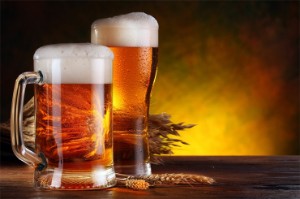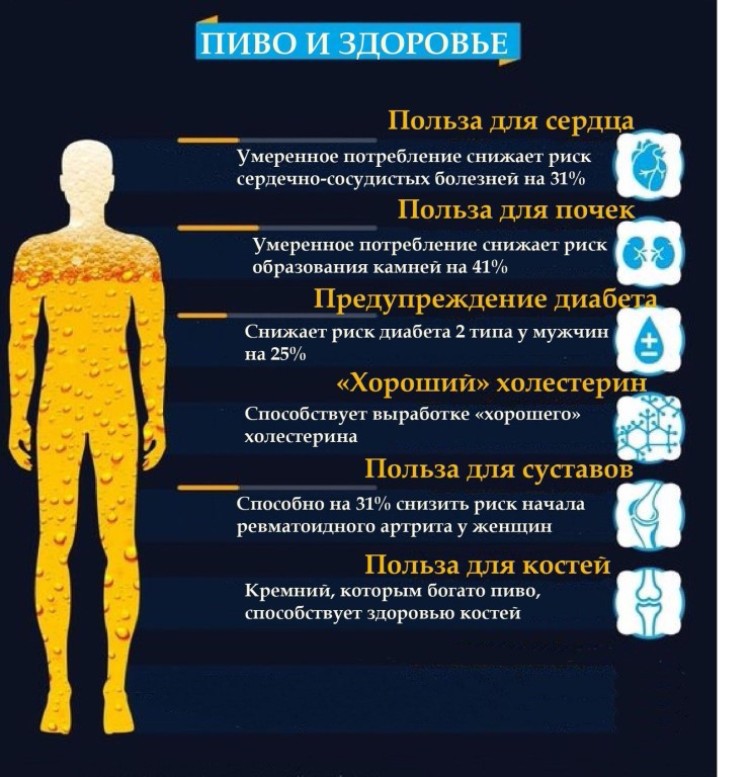A detailed overview of the effect of beer on blood vessels: does it widen or narrow their lumen?
 It is believed that it is useful for hypertensive patients to drink beer. They say that this drink helps to expand the lumen of the arteries, which lowers blood pressure.
It is believed that it is useful for hypertensive patients to drink beer. They say that this drink helps to expand the lumen of the arteries, which lowers blood pressure.
But how much does this correspond to reality with scientifically ? What do doctors say about this?
And if beer is useful to drink, then how often and in what quantity? Does this drink dilate the vessels or constrict them? Will it harm other organs?
Content
How does a hoppy drink affect blood vessels?
 Like any alcohol, beer really dilates blood vessels, that is, in theory, the pressure decreases in this case, as the lumen in the blood arteries, capillaries, and veins increases
, and the pressure on their walls decreases from this. All this is complemented by the diuretic effect of beer.
Like any alcohol, beer really dilates blood vessels, that is, in theory, the pressure decreases in this case, as the lumen in the blood arteries, capillaries, and veins increases
, and the pressure on their walls decreases from this. All this is complemented by the diuretic effect of beer.
However, in practice the situation is somewhat different. After a small amount of foam drink (about 0.25 – 0.5 liters), the pressure decreases slightly. Literally by 5 to 8 millimeters of mercury (refers to systolic pressure).
If you drink more, the vessels expand even more, but at the same time the heart rate increases significantly. That is, the heart begins to pump blood more actively. And from that moment on, the pressure begins to rise abruptly.
This may also be supplemented by renal dysfunction (for example, in the active stage of inflammation or insufficiency), since the kidneys are directly involved in regulating blood pressure.
How does this drink still affect blood vessels? Several key effects can be identified:
- The risk of thinning of the walls of arteries and veins is increasing. This is due to the fact that beer acts as an antispasmodic. All that harms blood vessels .
- The risk of cholesterol plaques increases. There is a fairly large amount of maltose in the foam drink, which is transformed into glucose. And with its elevated blood level, micro-lesions appear on the inside of the vessel walls, in which cholesterol accumulates. Therefore, the statement that beer helps clean the vessels , is a misconception.
- Improves elasticity. Precisely due to the fact that it dilates blood vessels. But if beer is abused quite often, then a harmful effect occurs – thinning of the walls. And such vessels are more prone to ruptures (this is what happens with a heart attack, stroke).
Harm to other organs
How else can beer harm the body? Doctors identify several of the most dangerous consequences:

- Kidney failure. Beer disrupts the normal water-salt balance, which is regulated by the kidneys. If abused, the urinary system simply stops coping with the load. In some, this causes pyelonephritis, in others – urolithiasis (the advancement of concretions through the ureter).
- Liver failure. Ethyl alcohol included in the composition of beer is excreted through the liver. But it is a powerful toxin that gradually destroys liver cells.
- Heart failure. A sharp increase in heart rate provokes a decrease in the density of the muscle fibers of the heart. Often all this "pours out" into a malfunction of the sinus node or a microinfarction, it can also lead to Beer heart syndrome &171;187; .
- Increases the load on the pancreas. It produces insulin, which is necessary for the oxidation and absorption of glucose. But often rising blood sugar levels provoke fibrosis of the gland tissue, which simply stops producing enough hormones.
- Worsens the work of the central nervous system. Ethyl alcohol derivatives destroy cells of the nervous system. Those, in turn, practically do not recover. Beer also contributes to atherosclerosis of the cerebral vessels.
- Increases the volume of adipose tissue. The maltose contained in the drink is processed to glucose, but is practically not used for energy synthesis. Accordingly, this will lead to an increase in body fat mass.
It is also worth mentioning that beer abuse can worsen visual acuity, as pressure increases in the eyeball. This is complemented by a deterioration in the neural connection between nerve cells (which affects the sensitivity of the optic nerve).
Is there any benefit?
The only benefit of drinking beer is reduction of puffiness due to diuretic action
. But it is much more effective to use the same tincture of horsetail for this purpose – it is absolutely harmless, practically does not violate the salt balance. But after a foamy drink, quite often there is a sharp decrease in potassium levels, but sodium grows (they inhibit each other), which, in excess, has a toxic effect.

It is also worth mentioning
the presence of a large amount of B-group vitamins
in beer (which are included in the composition of hops – the main component of malt).
However, in some cases vegetables and fruits that are useful for the heart and blood vessels (pineapple, avocado, pomegranate) there are many times more of them. It is better to give preference to fresh fruits and vegetables than alcoholic beverages.
Also check out our list of 20 of the most healthy foods for blood vessels , and choose the ones you like best.
It is often possible to hear that the use of this drink – good prevention of urolithiasis. In theory– yes, but if there are already formed concretions in the urethra, then the diuretic effect can provoke their movement through the ureter and its blockage. Such "prevention" is categorically not recommended by doctors.

And what can I drink instead?
How can it be replaced?
 It is believed that dry red wine is good for blood vessels
, and is less harmful to the body as a whole. This is partly true. It contains significantly less sugar, and there are also phytoncides that have a positive effect on the functioning of the entire cardiovascular system.
Wine also expands the vessels
.
It is believed that dry red wine is good for blood vessels
, and is less harmful to the body as a whole. This is partly true. It contains significantly less sugar, and there are also phytoncides that have a positive effect on the functioning of the entire cardiovascular system.
Wine also expands the vessels
.
What other alcoholic beverages can be called less dangerous? Any strong ones without sugar (or with a minimum amount of it) and gas. This can include cognac, whiskey, scotch, tequila, absinthe, vodka. In small amounts, they cause minimal harm to the body, do not affect glycemic metabolism and are quickly neutralized by the liver.
We talked about the effect of cognac on blood vessels here.
But low–alcohol cocktails with gas are among the most harmful. Unlike the same wine, ethyl alcohol is absorbed slowly from them (this is due to the presence of gas, as in beer).
What about non-alcoholic beer? It is less harmful, but it also increases blood sugar levels. Due to the high glycemic index, such drinks are strictly forbidden to drink with diabetes mellitus (both type 1 and type 2) - after them, glucose levels rise by an average of 4 mmol (this can even provoke a glycemic coma).
Interesting video
For a detailed introduction to the topic, we recommend viewing these videos:
In total, beer really helps to expand the lumen of the arteries. At the same time, the pressure initially drops, and after that it rises rapidly. A relatively "safe" amount of this drink is a volume of 200 to 400 milliliters. But in diabetes mellitus, renal hepatic and heart failure, it is categorically contraindicated. For hypertensive and hypotensive people, it should also not be used to regulate blood pressure – the harm from this will be much greater than the conditional benefit.


